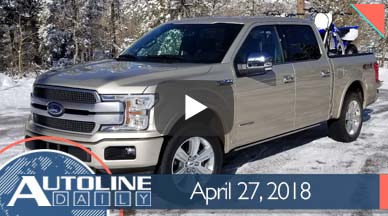
Runtime: 8:54
0:29 Ford F-150 Diesel Impressions
2:19 Hyundai Reveals New Sporty Sedan
2:40 Weekend Races
3:30 How Many Countries Ship Cars to U.S.?
4:11 Daimler Brings Garbage Truck to North America
4:43 BMW Helps Create Hyperloop One Capsule
5:41 Protecting Cars from Hackers
Visit our sponsors to thank them for their support of Autoline Daily: Bridgestone , Dow Automotive Systems and Lear Corporation.
On today’s show…I’ll share my driving impressions of the new diesel Ford F-150…do you know how many countries ship cars to the U.S.? and a look at how automakers are tackling cyber security issues. All that and more coming right up on Autoline Daily.
This is Autoline Daily the show for enthusiasts of the automotive industry.
FORD F-150 DIESEL IMPRESSIONS
The diesel engine isn’t dead yet. They’re actually finding new life in the light-duty pickup segment, helping provide fuel economy numbers many people thought would be impossible not all that long ago. We just got our first chance to test out Ford’s new F-150 diesel and here’s how it performed. The worst fuel economy we got was while towing a small horse trailer. We averaged a little over 13 miles to the gallon on a 22-mile loop that only had a few traffic stops. One truck with a few hundred pounds of payload in the back yielded about 19.5 MPG while driving up into the Rocky Mountains. And babying the truck with no weight, on pretty ideal road conditions and only a few traffic lights, we were able to top 31 miles to the gallon. Some hypermilers on the same route were actually able to top 40 MPG. Overall, we think the EPA numbers of 22 city, 30 highway and 25 combined are pretty spot on. But beyond fuel economy, the engine, which shares its basic design with a V6 diesel that goes in a number of Jaguar Land Rover products, seemed pretty well refined. Engineers did a good job calibrating the software to the 10-speed transmission. Now let’s talk price. The most anyone will spend is $4,000 and that’s coming up from 2.7L EcoBoost V6. it’s as little as $2,800 when moving from a 3.5L EcoBoost. The engine is available for retail customers in Lariat, King Ranch and Platinum models, while fleet customers can choose it on all trim levels. Ford expects the engine to be about 5% of F-150 sales and mainly expects to attract people that have something to tow.
HYUNDAI REVEALS NEW SPORTY SEDAN
Hyundai introduced a new sporty sedan for the Chinese market at the Beijing auto show called the LAFESTA. The name means “Festival” in Italian. It features the company’s new design language and is powered by a 1.6L turbo that’s mated to a seven-speed dual clutch transmission. The LAFESTA goes on sale in China at the end of the year.
WEEKEND RACES
And here’s what’s coming up this weekend in racing. The Formula 1 race in Azerbaijan is Sunday at 8:10 in the morning, Eastern Time on ESPN2. NASCAR runs at Talladega on Sunday at 2 PM ET on Fox. And lastly the NHRA 4Wide Nationals starts at 6 PM Eastern Time on Sunday on Fox Sports.
Do you know how many countries ship cars to the U.S.? We’ll tell the answer, right after this.
HOW MANY COUNTRIES SHIP CARS TO U.S.?
The U.S. imports millions of cars every year, but do you have any idea how many different countries it imports cars from? I’ll bet you can’t, because we couldn’t either! The answer is that the U.S. imports cars from twenty-one different countries. That may be an all-time record. And here are four cars in particular that caught us off guard. Did you know the 5-door Honda Civic hatchback comes from the UK? Same goes for the Infiniti QX30. We were also surprised to learn that the Toyota Yaris comes from France and that the Toyota CH-R comes from Turkey. Talk about a global industry.
DAIMLER BRINGS GARBAGE TRUCK TO NORTH AMERICA
Daimler Trucks, with its Freightliner and Western Star brands, controls 40% of the medium and heavy-duty market in North America. And it’s looking to expand its dominance with the introduction of the Freightliner Econic SD. It’s a garbage truck sold in Europe but over there it’s a Mercedes-Benz. It’s powered by a 350 horsepower in-line 6-cylinder engine that’s built in Detroit. The truck is made in Germany and will be shipped to South Carolina where it will be modified for the North American market.
BMW HELPS CREATE HYPERLOOP ONE CAPSULE
BMW’s design studio subsidiary, Designworks, teamed up with Virgin Hyperloop One and the city of Dubai to create a prototype passenger capsule. The Hyperloop is a transportation system that electromagnetically propels the capsules through a vacuum tube at speeds over 1,000 kilometers per hour or about 670 miles per hour. A trip from Dubai to Abu Dhabi would only take 12 minutes. There aren’t any windows in the capsule, so Designworks helped create an interior that’s comfortable and not restrictive.
Coming up next, a look at how General Motors is protecting its cars from hackers.
PROTECTING CARS FROM HACKERS
Cyber security is a growing concern in the auto industry. But it’s not enough to just protect cars from hackers, automakers must look at their entire operation. On Autoline This Week, we’re joined by Kevin Tierney, the Chief Product Cybersecurity Officer at General Motors. Here’s what he had to say about knowing when it’s better to tackle security issues in house or when it’s better to go outside the company.
(The ATW preview is only available in the video version of today’s show.)
For more about how automakers are protecting cars from hackers, you can watch that entire discussion right now on our website Autoline.tv or you can find it on our YouTube channel.
But that’s it for today, thanks for watching and we’ll see you again on Monday.
Thanks to our partner for embedding Autoline Daily on its website: WardsAuto.com

John McElroy is an influential thought leader in the automotive industry. He is a journalist, lecturer, commentator and entrepreneur. He created “Autoline Daily,” the first industry webcast of industry news and analysis.




